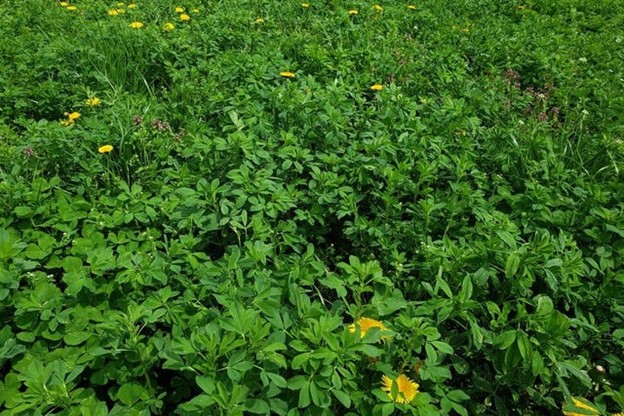 Image credit: Penn State Weed Science; Dwight Ligenfelter - https://extension.psu.edu/early-season-weed-control-in-alfalfa
Image credit: Penn State Weed Science; Dwight Ligenfelter - https://extension.psu.edu/early-season-weed-control-in-alfalfa
- Healthy stands of alfalfa may require additional weed control to improve hay quality and stand longevity.
- The best tactics for control perennial weeds begin before planting alfalfa.
- Proper herbicide timing in-crop is crucial to maximize weed control and avoid delayed harvest because of label-mandated preharvest intervals.
Weed infestations can reduce the yield, quality, and longevity of alfalfa stands. Low soil pH conditions, inadequate fertility, poorly timed insect management, and improper mowing can result in weak alfalfa stands and weed infestations. Although the most effective weed management programs encourage a healthy alfalfa stand, healthy stands may need additional weed management. Several factors must be considered in selecting herbicides for alfalfa including:
- Stand age: Many herbicides that are safe on established alfalfa cannot be used on seedling alfalfa. Seedling alfalfa is usually defined as alfalfa that is less than 1 year old. In general, there are fewer herbicides available for use in seedling alfalfa than in alfalfa that is more than a year old (aka “established” alfalfa).
- Weed identification: Careful identification of weed problems will permit proper selection of herbicide programs.
- Herbicide application timing: Proper application timing will improve weed control, and avoid conflicts with harvest restrictions and crop injury.
- Soil conditions: Soil properties such as texture, pH, and organic matter content influence herbicide efficacy and therefore are determinants of application rate.
- Crop and land use restrictions: The length of time between herbicide application and forage harvest (Pre-Harvest Interval, PHI) may influence herbicide selections. Most herbicide labels restrict forage harvest from 7 to 30 days after herbicide application.
Seedling Alfalfa Stands
Perennial Weed Management
Weed management in a new alfalfa stand should begin well in advance of seeding. Perennial weeds (including bindweed, Canada thistle, curly dock, plantain, dandelion, johnsongrass, quackgrass, and others) are a primary concern since management options for controlling them in established alfalfa are limited unless you can use glyphosate in Roundup Ready® alfalfa. Regardless of whether or not Roundup Ready® alfalfa is used, perennial weeds should be intensively managed beginning one or two years before alfalfa establishment. Multiple applications of nonselective, translocated herbicides, such as glyphosate, 2,4-D, and dicamba will effectively control the root systems of most perennial weeds. Keep in mind you will have a preplant interval to accommodate if you use 2,4-D or dicamba.
Options for controlling perennial weeds after alfalfa establishment are more difficult to implement, and less effective than control before stand establishment, especially control of perennial broadleaf weed species. Poast® or clethodim can be used for control of johnsongrass, quackgrass, and other perennial grasses after alfalfa establishment. Velpar Alfamax®/AlfaMax Gold® can be used for dandelion and plantain. Glyphosate can be used in Roundup Ready Alfalfa for grasses and broadleaves, but glyphosate is typically less effective on some broadleaves than it is on grasses in general.
Annual Weed Management
Winter annuals are most likely to invade during periods of alfalfa dormancy. Weed control in the first dormant period is critical for stand establishment. Metribuzin will control many winter annual weeds and is commonly used during the dormant period. Herbicides that can be used for winter annuals after the alfalfa comes out of dormancy include clethodim for winter annual grasses, Pursuit®, Chateau® primarily for winter annual broadleaves, and Glyphosate and Extreme® in Roundup Ready® alfalfa for both grasses and broadleaves.
Established Alfalfa Stands
Perennial Weed Management
Perennial broadleaf weed management herbicide options for established alfalfa stands are very limited, with the exception of glyphosate and Extreme® in Roundup Ready alfalfa. Velpar AlfaMax®/AlfaMax Gold® provides some control of dandelion and plantain. Poast® and clethodim are labeled for perennial grasses (i.e. johnsongrass, and quackgrass). Clethodim is generally better for control of perennial grasses, while both products provide acceptable control of annual grasses.
Annual Weed Management
There are over a dozen herbicides commonly used in alfalfa for postemergence weed control in established stands. Consult the Crop Protection Handbook for more specific details on what weeds are controlled by each herbicide and details about application timing. Some of these herbicides are labeled for dormant (early spring before greenup) or post-harvest applications (less than 2 inches of regrowth after hay harvest) only. Although these herbicides are affective, careful planning is needed to ensure their timely applications. Gramoxone®, Sencor®, and Velpar AlfaMax/AlfaMax Gold® are effective for controlling many broadleaf weeds but must be applied to dormant alfalfa. Also keep in mind the PHI for each herbicide will vary. The shortest PHI is for glyphosate, which must be applied a minimum of 5 days before planting. PHI’s can be longer as Pursuit® has a 30-day pre-harvest interval that may not fit with aggressive harvest schedules.
Consult with your local FS Crop Specialist for help with planning your weed control strategies for alfalfa.
Related categories: alfalfa, weed control, perennial weeds